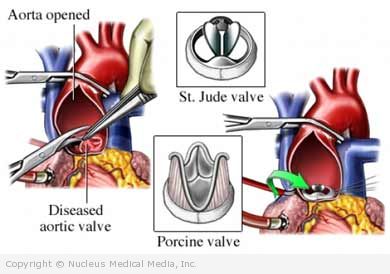Aortic stenosis in adults
(Stenosis, Aortic — Adult; AS — Adult)
Aortic stenosis in adults – Definition
The aortic valve is located between the left ventricle of the heart and the aorta (the largest artery in the body) that supplies blood throughout the body. Aortic stenosis (AS) is a narrowing of the aortic valve that could block blood flow from the heart and cause a back-up of flow (and pressure) in the heart and to the lungs. AS disease can range from mild to severe.
Aortic stenosis in adults – Causes
The main causes of AS include:
- A birth defect of the aortic valve, which normally has three cusps:
- An aortic valve that has only one cusp or is otherwise stenotic from birth
- A bicuspid (two-part) aortic valve with progressive wear and tear
- Progressive hardening of the aortic valve with age (most common in elderly)
- Scarring of the aortic valve caused by rheumatic fever (rare)
Aortic stenosis in adults – Risk Factors
Factors that may increase the risk of AS include:
- Gender: male
- Family members with heart disease that affects the valves
- History of rheumatic fever
Aortic stenosis in adults – Symptoms
AS does not always produce symptoms. But if symptoms do occur, they may include:
- Extreme fatigue after exercise or exertion
- Fainting with exercise or exertion
- Pain, squeezing, pressure, or tightness of the chest usually occurring with exertion
- Sensation of rapid or irregular heartbeat (palpitations)
- Shortness of breath
- Dizziness with exertion
- Neurological symptoms of a stroke or transient ischemic attack
In rare cases, AS can cause abnormal heart rhythms ( arrhythmia) or sudden death with no previous symptoms.
Aortic stenosis in adults – Diagnosis
The doctor will ask about your symptoms and medical history. A physical exam will also be done. The doctor may be alerted to AS by the following:
- Abnormal chest sounds (eg, heart murmur or clicking sound)
- Noticeable chest heave or vibration when the doctor’s hand is held over your heart
To confirm the diagnosis, tests may include:
- Chest x-ray
- Electrocardiogram
- Echocardiogram
- Cardiac catheterization
Aortic stenosis in adults – Treatment
If you have mild AS, your condition will be monitored, but may not need immediate treatment. If you have more severe AS, your doctor may advise you to avoid strenuous physical activity. If necessary, you may be given medicines to help prevent heart failure.
If you have mild AS, your doctor will monitor your condition. You may not need immediate treatment. If you have a more severe case, though, your may instruct you to avoid strenuous activity. If needed, you may be prescribed medicine, and surgery may be required. Examples of surgery include:
Aortic stenosis in adults – Surgery
- Balloon valvuloplasty — A balloon device is passed through the arteries to open or enlarge the stenotic aortic valve. This may provide temporary relief of symptoms. But since the valve can become blocked again, this treatment is not a permanent solution.
- Aortic valve replacement — During this open surgery, the defective heart valve is replaced with either a bioprosthetic valve (made from an animal) or a synthetic valve.
- Transcatheter aortic valve replacement — This surgery also involves replacing the defective valve. But this is minimally invasive surgery that involves inserting the replacement valve through a small incision in the chest or through an artery in the leg.
Aortic stenosis in adults – Prevention
AS cannot be prevented. But if you have AS, there are several things you can do to try to avoid some of the complications, such as:
- Get regular medical care, including exams and tests.
- Only certain people with AS need antibiotics before dental or medical procedures. Ask your doctor if you need antibiotics to prevent infection of the heart valve.

